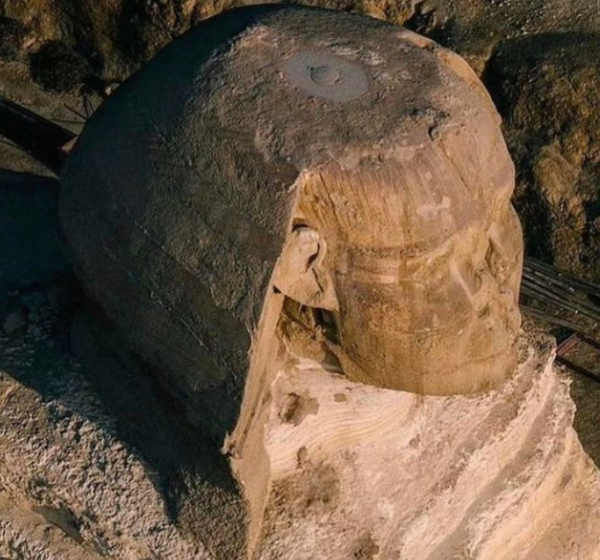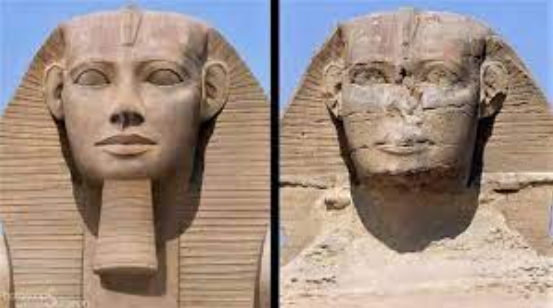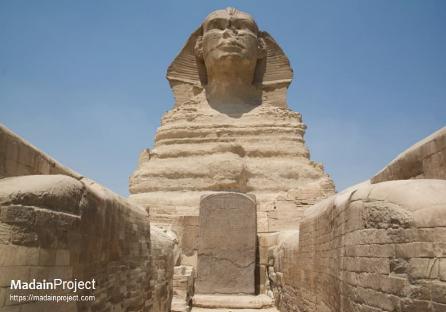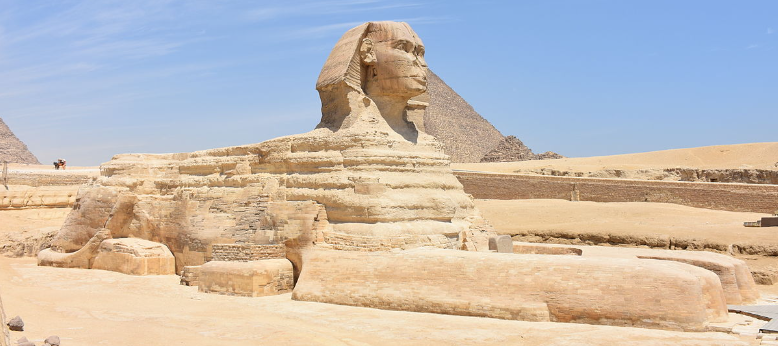Interviewer: Good afternoon Sphinx! It’s great to have you here and I’m looking forward to learning so much about you! Let’s start off with the basics, please introduce yourself!
Great Sphinx: It’s great to be here. I’m the most beautiful sphynx you will ever meet, the Great Sphinx of Giza. I’m 4,600 years old, built by Pharaoh Khafre as part of his burial site. I stand proud at 65 feet tall, my gorgeous lion body is almost 190 feet long, and I wear a royal headdress on my human head, because I’m royalty, of course. I’m made of limestone and I have very obvious, and obviously beautiful, stripes all across my body. I was buried in sand up to my shoulders until about 100 years ago.

Interviewer: Wow! It must have felt so great to be freed from all that sand.
Great Sphinx: Not really. I would have rather stayed buried and undiscovered if it meant I could keep the cement out of my head. One moment I was snug and cozy in the sand, taking a nap, and next thing I know some humans are trying to “restore” me. Just ask J. Meier-Graefe, he wrote a whole article about how researchers ruined my image by pouring cement in my head, he even said my image was destroyed because of it. I know my head was worn down but the cement was unnecessary and uncomfortable! My body was doing just fine under all that sand too, but when they dug it all up it just damaged my body even more. Is it so hard to just leave me be? If I break apart, I’ll break apart, because that’s just what happens when you’re a few thousand years old.

Interviewer: Yikes! Do you think these damages interfere with your ability to do your job? As a matter of fact, what is your job exactly?
Great Sphinx: Great question! I don’t know!
Interviewer: You don’t know why you were made?
Great Sphinx: Oh, I do, but that’s a secret I’ll never tell. You humans have to figure that out yourselves. But I will tell you about my favorite theories because you humans always think of the wildest things! My favorite is the one connecting me to the Sphinx Temples for some kind of celestial purpose involving an eclipse. They say that the Sphinx Temple is a sun temple and that I represent the pharaoh presenting an offering to the sun god. Other theories say I’m a guardian. I also like the theory that I was built by Khafre’s half-brother, Djedefre, to commemorate Khufu, because it would bring up a lot more questions about why I’m in Khafre’s burial complex. Some said my face looks more like Khufu than Khafre, which is weird since my face isn’t exactly complete.
Interviewer: Speaking of that, could you talk more about your infamous broken nose?

Great Sphinx: Nose and beard. Everyone knows my nose is gone, but everyone forgets I had a beard. During the 18th Dynasty, I snuck into Thutmose IV’s dream and offered him the throne in exchange for his help in restoring me. He got his throne and kept his promise, but he was so honored by my presence, as he should be, that he added a beard to make me look better too! It fell off a while ago, don’t remember when because I was taking a nap when it happened, but a piece of the beard was hauled off to the British Museum in 1818. Why does the British Museum still have it anyways? I want my own beard back since, you know, it was mine in the first place. Anyways, back to the nose. You humans think it might have been some guy named Saim-al-Dahr in the 1300s who defaced me, but it was actually done by Napoleon’s super racist troops about 200-300 years ago. They blasted my nose off with a cannon because of my “typically Negro” features that appeared on a portrait of me from 1798.
Interviewer: How interesting! As we are running out of time, I want to conclude with one last question. What is your favorite mystery regarding yourself?
Great Sphinx: Definitely my name. The word “sphinx” is from Greek mythology and appeared 2,000 years after I was built. I’m much more beautiful than any Greek or Asian sphinxes, yet people continue to call me a sphinx because no one knows my real name! The first time the Egyptians wrote me down was when Thutmose IV called me “Horemakhet,” meaning Horus in the horizon, in his Dream Stele. Other New Kingdom steles call me the same, but no one knows what people called me when I was freshly built 4,600 years ago.

Interviewer: I never knew that! Maybe the next time we meet, Egyptologists will have found some new ancient texts that finally solve all of your mysteries!
Great Sphinx: I hope not! Mystery is a good thing. I’d like to stay a greater mystery than the Pyramids for the rest of my life. Secrets should just stay secret because the mystery just adds to my charm!
About the Author:
Marina Rizk is a part of the class of 2026 and is looking to major in Chemistry. Although she grew up in New City, New York, Marina was born in Egypt and is always looking to learn anything and everything about Ancient Egyptian life, culture, and monuments.
